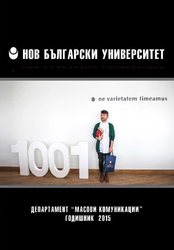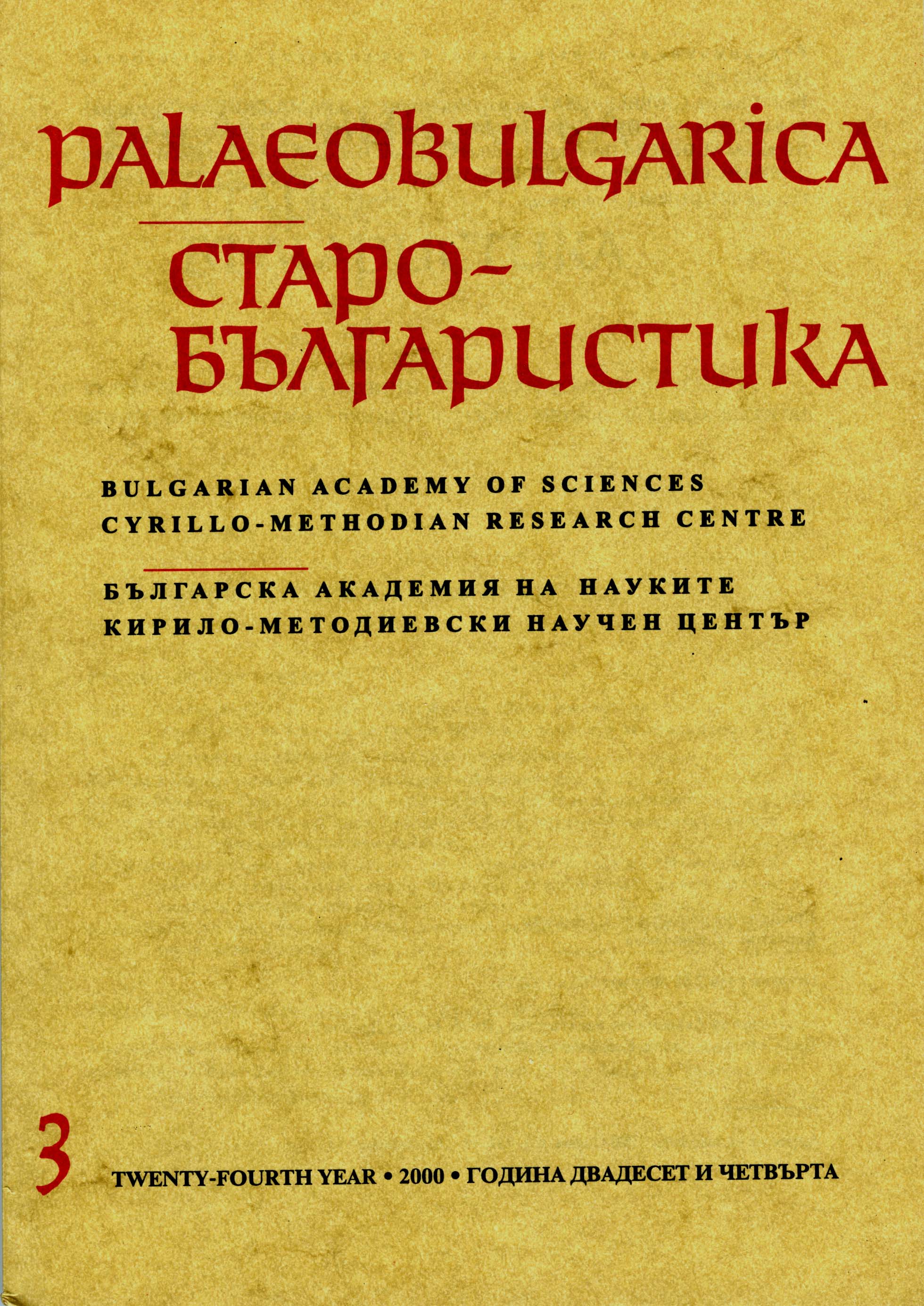
We kindly inform you that, as long as the subject affiliation of our 300.000+ articles is in progress, you might get unsufficient or no results on your third level or second level search. In this case, please broaden your search criteria.


In the article “Conversations in the Smart Space" by prof. Rusi Marinov, D.Sc. are monitored the development, principles and models of smart work systems, theories of conversation and their modifications in the modern environment. Analyzed are new forms of communication such as M2M and IoT.
More...
Prof. Vladimir Mihaylov, D.Sc. in "Media Studies are Dead, Long Live Media Studies" points out that the technology Web 2.0 changes the media, changes the principle of communication, changes the way of communication in and through media content. So it seems the end comes for the familiar Media studies 1.0 and we should welcome the new born Media Studies 2.0.
More...
The main idea in the study "The more Theories about Leadership - The Less Successful Leaders in Our Country" from prof. Tolya Stoitsova, D.Sc. is that despite the proliferation of theories about leadership in psychology science, we can not say that the practice of people management in the country is significantly improved. The article advocates the idea that competence in a leadership is directly connected with the communication competence.
More...
In the text "Broadcast News Inside" Prof. Mihail Meltev, PhD deals with the production of television news and the role of the producer. The author points out that the fight for viewers saturate the news with colorful graphics, computer effects, lighting effects and everything depends on the taste and measure of the producer and the director of the news.
More...
In the study "Cinema in Shadow" Assoc. Prof. Petia Alexandrova, PhD shares her thoughts about cinema after 1989, which ceases to be a prestigious and wealth bringing occupation and becomes a shadow of itself from the 70s and 80s of the twentieth century. But somewhere off the main stage is formed a niche for small and medium formats as an alternative: short movies, movies omnibuses, independent, experimental and art projects, hybrid forms between video, performance and avantgarde.
More...
The "Reflecting the Recent Past by Media Service Providers" by Assoc. Prof. Raina Nikolova, PhD examines the role of the media in keeping the national memory. By movies and news media reports, the media is invited to participate in the study of archives to establish the truth about the recent past together with the history researchers.
More...

"The Impact of National Branding on National Identity" by Boryana Gosheva examines the efforts of post-Communist Bulgaria to rethink its national image in favor of branding of the nation. The aim of the programs of building national brand is to create and position the new image to the outside world as well as to revive national pride. Through critical interpretive approach, this article presents an analysis of the symbolism in branding campaigns of Bulgaria.
More...
In the text of Desislava Dankova is presented her own research on "Organizations in Bulgaria and the use of Social Media and Networks as a Channel for Communication with Consumers" The aim of the studies is to draw a picture corresponding to the reality of how organizations and companies in Bulgaria understand change and develop communication with the audience through social media and networks.
More...
This article presents a study of the Book of Prophet Ezekiel according to its oldest preserved Slavonic copy, in a middle Bulgarian collection of the 14th с. (F.I.461, Russian National Library, St. Petersburg). The purpose of this article is to clarify the level of similarity between the biblical text and its commentaries, according to the use of specific lexical and morphological translation methods. For this purpose we helped ourselves with the results obtained from the DBT program, software within which a variety of research at different levels of the language can be performed. The analysis of the data allows several basic conclusions. First, we define three groups in the Preslav lexical norm, being dominant in the examined text: lexemes with stable usage; lexemes with facultative usage, the variability of which remains within the framework of the Preslav usage; lexemes with older as well as Preslav tradition usage. Second, based on the analysed material, it is not possible to provide a complete parallel between the Book of Prophet Ezekiel with the associated (for comparison) non-liturgical translations of other Old-Testament books – Genesis, the Book of Prophet Isaia, the Book of Prophet Daniel. Third, the Book of Prophet Ezekiel shows irregularities at two levels: in the basic biblical text one may separate a more archaic level (reviewed chapters of the Prophetologion: 1, 2 and 37, and chapter 18), and differences in the translating methods in the language of the biblical text and in the text of the commentaries. This is in favour of the conclusion that there was a time distance between the translation of the biblical text and the creation of its commentaries, a distance preserved anyway within the traditions of the translation school of Preslav.
More...
This monument, which is included in the series of church-historical works, was drawn up in the 70s of the 12th c. It has reached the present on the basis of two manuscripts – Paris 880, and Moscow 886 (Vladimir 324). The Du Cange Catalogue was published several times, named, according to the Paris manuiscript, after its first publisher, the French Byzantinist Charles De Cange (1610–1688). In this publication are taken into consideration both manuscripts. On the basis of her observations and chiefly on the principal researches made so far, the authoress analyses the activity of the archbishops included in the Catalogue. Second, the place has been sought of the Catalogue in the development of the Archbishopric of Ohrid, called “Bulgaria”, and its importance as a Cyrillo-Methodian source is stressed.
More...
The article presents an analytic description of the contents of the M.S. Sin. Gr. 286 (13th c, Moscow, The State History Museum), a Byzantine miscellany of canon law with comments by John Zonaras. The manuscript preserves the second known copy of the List of the Bulgarian Archbishops, called also The Du Cange Catalogue after its first publisher. The text of this copy is published here for the first time. A comparision with the copy in Cod. Gr. 880 of the National Library in Paris is made.
More...
In the new 1999 edition of Savina Kniga is removed the arrangement of the leaves, disturbed during the last binding, which was reflected in the publication of the manuscript in 1903, and is introduced a pagination corresponding to the textual sequence. Besides that, the new edition includes the text of all the four parts of the hand-written book: the Old Russian supplement of the 13th c., leaves 1-24; the Old Bulgarian Savina Kniga of the 11th c, leaves 25-153; the Old Russian addition of the llth-12th c., leaves 154-165; the Old Bulgarian addition of the 11th c., leaf 166. For practical work, therefore, with the new edition are needed new reference books. This publication offers a Lectionary Calendar and a Lectionary Index by Evangelists in compliance with the new pagination. In the reference books the material of the four parts is differentiated. The additions needed according to the lost parts are indicated by square brackets. The description of the Menaion by names and definitions corresponds to the text of the manuscript.
More...
The article provides evidence that the identified by I. Sevcenko Old Bulgarian translation of Deacon Agapetos' mirror of princes Exposition of Heads of Advice to Emperor Justinian was written around the end of the 9th and the beginning of the 10th century. The image of Justinian as a god-elected, godlike and almighty emperor-philosopher, an embodiment of supreme Christian piety drawn by Agapetos was practically readdressed by the anonymous Bulgarian translator to Symeon I (893-927). The author of the article points to the existence of yet another (besides the three texts studied by Sevcenko) Slavonic translation of the Exposition made not later than the beginning of the 15th century. Published for the first time is the full version of the early 10th century Bulgarian translation of the Exposition following a Russian copy from the first half of the 15th century (State Historical Museum – Moscow, Synodal Collection, Cod. 489, f. 33v-47v) and including some variant readings from a 14th century Russian copy (State Historical Museum – Moscow, Uvarov's Collection, cod. 589, f. 140v-142v).
More...
The aim of this article is to present in a historical context the astronyms used for naming the two zodiacal signs Libra and Aquarius for which a great lexical variety due to different causes is noticeable. For the sign Libra the literal translation of the Greek name created the astronym Іарьмъ fully adopted by the Bulgarian men of letters who began to use also synonyms with the same meaning. In the case of Aquarius all the names, quite numerous, were subjected to one basic principle: indication of the connection with water and moisture. The illustrative material cited in the study bears witness to the diversity of the Bulgarian vocabulary of natural science in a historical aspect.
More...

Christian Dualist Heresies in the Byzantine World с. 650 - с. 1450; selected sources / translated and annotated by Janet Hamilton and Bernard Hamilton; assistance with the translation of Old Slavonic Texts by Yuri Stoyanov. Manchester Medieval Sources Series. Series advisers Rosemary Horrox and Janet L. Nelson. Manchester - New York: Manchester University Press, 1998. XVII + 327 pp.
More...
The Glagolitic psalter manuscript which was auctioned at Christie’s in 1998 presents a strikingly archaic appearance. However, an examination of its orthographical, linguistic and textual features reveals a range of enigmatic discrepancies. Its orthography is exceptionally inconsistent and various mechanical errors suggest that the copyist was not accustomed to writing in Glagolitic. The manuscript seems to derive from an early Cyrillic exemplar, probably the Bologna Psalter, but it contains distinctive linguistic forms and variant readings which are characteristic of later redactions of the text. The Cyrillic marginalia also display a dependence on the headings to the psalms in the Bologna Psalter. These peculiarities give rise to significant difficulties in dating the manuscript; its date therefore needs to be established by means of physical tests.
More...
The article is devoted to the little known Saint Varvar Mirotochets (Varvar the Holy oil Giver) whose cult is closely connected with Turnovo. The historical documents show that during the time of King Alexander the Patriarchy of Turnovo, emphasizing its independence from that of Constantinople, did not buy holy oil from the “Mother Church” and used the holy oil exuding from the relics of St. Dimiter of Salonika and St. Varvar of Bitolja. The detailed vita was published already at the end of the past century by A. I. Yatsimirski, who had discovered it in a Moldovian manuscript of 1448, autograph of Gavriil Urik. In the copy known to Yatsimirski at the end of the Life there is an addition according to which it was written in 1435. In this publication are given all the archaeographic data on the five hitherto known copies of the work, supported are the already expressed assumptions that Cyprian was the author only of the verses and that the Life is an anonymous literary monument that appeared in Turnovo about the middle of the 14th c, but up to 1371. The comparison between the Slavonic text and the Greek works of Constantine Acropolitis and Akakius shows that the Life is a highly artistic rhetorical work of a metaphrastic type, reflecting a Bulgarian transformation of the cult of St. Varvar of Hellas, in which the image is considerably altered and above all is stressed the important for the Bulgarians “holy oil giving” of the hero.
More...